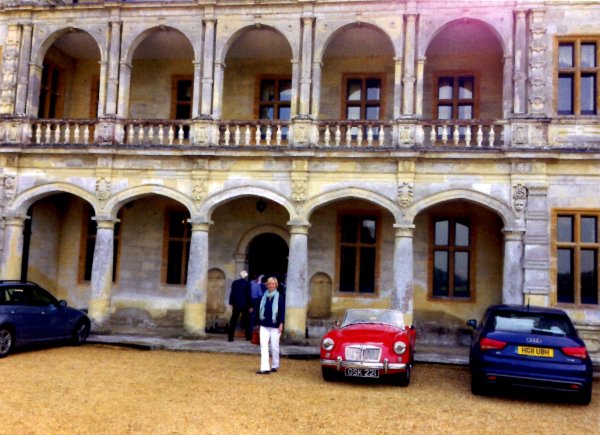Trust's Visit to Longford Castle - TrustNews December 14
Longford Castle is indubitably a ‘hidden jewel’. lt is a quite astonishingly beautiful building in a mouth-watering position on the banks of the River Avon, and contains one of the finest private collections of paintings in the United Kingdom. The collection has been put together by successive generations of the family and includes paintings by van Dyck, Rubens, Claude Lorrain, Teniers and Hals, alongside a wealth of British portraits by Reynolds and Gainsborough just for starters. The family is advised by the National Gallery on their art collection, which includes an exceptional collection of 18th century English and continental furniture, oriental porcelain, and Brussels tapestries. Yet not many seem to know of the Castle’s existence.
It was originally built in the late 16th century by Thomas Gorges, on a triangular Swedish pattern with the main building having several floors and a round tower in each corner (the three towers representing the Father, the Son and the Holy Ghost). In 1717 Longford Castle was purchased by Sir Edward des Bouverie, having made a fortune from trading in the Levant. Subsequent generations of the family beautified the interior of the castle and surrounding park. Then, in the 18th century, the second Earl of Radnor, employed the architect James Wyatt to transform it into a hexagonal palace. This project was abandoned part way through and it was left to the fourth Earl of Radnor and Victorian architect Anthony Salvin to complete the building. Longford Castle is currently the seat of William Pleydell-Bouverie, 9th Earl of Radnor.
The entrance gates to Longford Park and Castle revealed little of the spectacle that greeted us on our approach to the castle itself and we had to wait at the gates before being allowed through in convoy - led by David Marklew’s red MGA. Our first spectacular view of the (West) face of the castle was on the right side - a deliberate objective of positioning the driveway as a curve.
On arrival Sue Owers, whose idea this visit was, introduced us to our guide Alexandra Ormerod who in turn led us through to the Triangular Hall in the centre of the castle. Alexandra and her colleague Paul then took us through those rooms that the family open for these visits. They impressed us with their knowledge and provided many colourful anecdotes relating to the family and their wonderful collection. Most stories related to the paintings but one was about an intricate steel armchair dated 1574 probably presented by the City of Augsburg to the Holy Roman Emperor Rudolf II and looted by Swedish troops in 1648 before being sold to the second Earl of Radnor for the astonishing sum of £1000 ( £18million in today’s money). Then, in the 1930s, Goering tried to persuade the family to sell it to him and this could have been part of the reason that Longford Castle was on the Nazis “Do not Bomb” list. As it was the castle was used as HQ for Montgomery's V corps during the war.
After our tour of the castle we had time to explore the garden — also very fine in its setting, layout and planting. We were told that the present Countess had since 2009 taken on its regeneration with advice from the Garden Museum.
It was a very happy and contented group of about 16 of us who, on this perfect late - summer’s day, repaired for lunch to The Radnor Arms in the nearby village of Nunton.

